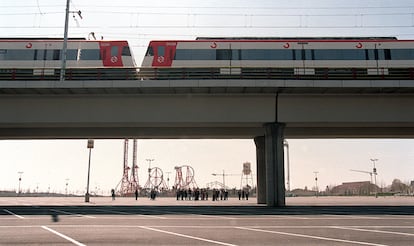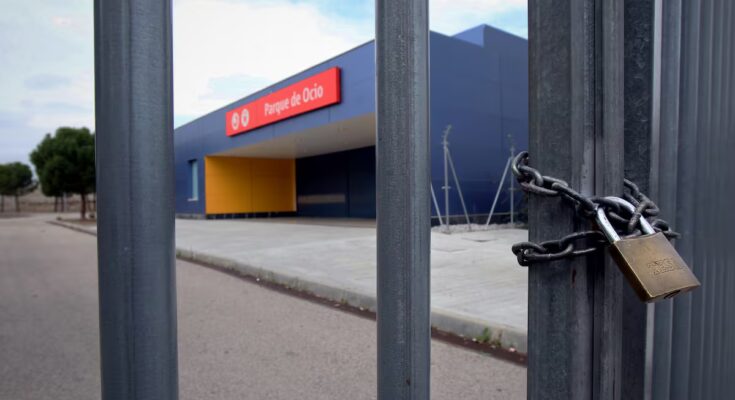Justice has forced the government of Isabel Díaz Ayuso, in the Community of Madrid, to pay compensation of 7,560,102.77 euros to a company whose exploitation of a gypsum mine was compromised by expropriation to build the Cercanías train, designed by the executive of Alberto Ruiz-Gallardón (1995-2003) to serve the Warner amusement park and the city of San Martín de la Vega in connection with Pinto. It is the culmination of a total failure. The work cost 85 million euros. The train was inaugurated in 2002. In 2012, when just ten years had passed, it stopped running due to lack of passengers. And now, according to the documentation to which EL PAÍS has access, the amount of money wasted grows by almost ten million after the Superior Court of Justice of Madrid (TSJM) ruled against the requests of the Administration, which deemed the compensation of 1,105,142.99 euros sufficient, plus the corresponding legal interest, set by the Jury for the Territorial Expropriation of the Community of Madrid in 2022.
This is the story of a disagreement. Another, between Gallardón and his successor, Esperanza Aguirre, who was president from 2003 to 2012. The regional executive did not limit itself to promoting a railway line about which there were doubts from the beginning. He even owned 46% of Warner Park, a complex of roller coasters and attractions with thousands of visitors. A year after becoming president of Madrid, Aguirre began to question the profitability of the project’s investment, until in 2006 the Community sold its stake for 40 million. It was not the last point of the correction to Gallardón. In 2012, Aguirre once again freed himself from his predecessor’s management by ordering the closure of the railway line, operated by the Spanish government as it was a Cercanías railway line, “due to low demand”.
“This line proved to be unprofitable, it cost the Transport Consortium almost four million a year,” acknowledged the then general director of infrastructure, Raimundo Herráiz Romero, in the Transport commission of the Madrid Assembly. And he offered an enlightening piece of information: “The branch from Pinto to San Martín de la Vega came at a time when the average occupancy of the trains was 16 passengers/train.”
This is the cold note with which the regional executive now faces the last chapter of the fiasco, and its judicial defeat, according to the documentation consulted by this newspaper: “Agreement which authorizes expenditure for an amount of 7,560,102.77 euros, corresponding to the payment of the price of expropriation of the mineral rights deriving from the exploitation authorization “Monte Espartinas” number A-72 affected by the work: “New railway access to the theme park and San Martín de la Vega”.
The ruling that caused the payment also criticizes the Community’s slowness in addressing its responsibilities, which drove up the final bill. “Although the occupation took place in December 2000, as shown in the minutes drawn up for this purpose, the actual start of the fair price practice however took place in December 2020 (date of request by the expropriating Administration for an appreciation sheet from the expropriated party)”, we read. “Naturally, this 20-year delay can be attributed entirely to the Administration.”
This newspaper contacted the regional government to expand on this information, but had not received a response at the time of publishing this article.
The payment of compensation once again confronts the current government with a poisoned legacy created by its predecessors. If today it is a Gallardón project that forces the Ayuso government to withdraw its checkbook, it has already happened with other Aguirre fiascos. The invoice? Hundreds of millions of euros thrown in the garbage.
Thus, the executive of the PP and Cs coalition, also led by Díaz Ayuso, decided in January 2020 to pay 99.5 million euros between 2020 and 2024 to the six public universities of Madrid to compensate for the cuts decided in the 2007-2011 investment plan, promoted by the previous baroness. It was the culmination of a legal battle that the Community has always lost, with around thirty rulings against and in favor of the universities, which ultimately resulted in a millionaire outlay: over 574 million.
On the same line, the breakdown of the train that was supposed to connect Móstoles to Navalcarnero, and which the Spanish government is studying to recover, cost the current Administration 162 million… without a single train having ever circulated.

Worse is the case of metro line 7B, also promoted by Aguirre, and which has been partially closed for three years, after causing the demolition of 73 homes in the Madrid town of San Fernando de Henares. Putting it back into operation, as will happen on November 22, and compensating those affected, as the Community is doing, involved an outlay of 171 million euros.
Furthermore, the City of Justice, for which Aguirre spent a sum of one million dollars without constructing more than one building, will now see the light, 20 years later, and for an expected expenditure of 653 million euros.
And with Ayuso at the helm, Madrid also had to pay 73 million euros to the construction company of MP-203, a toll motorway launched in the Aguirre era, on which not a single car has ever driven, and which has not even been completed.
Perhaps this is why the current administration has experimented several times with the possibility that the Spanish government, or a private operator, could once again operate the San Martín de la Vega train, whose tracks run parallel to the road that gives access to Warner Park without anyone using them. So far, without success.



